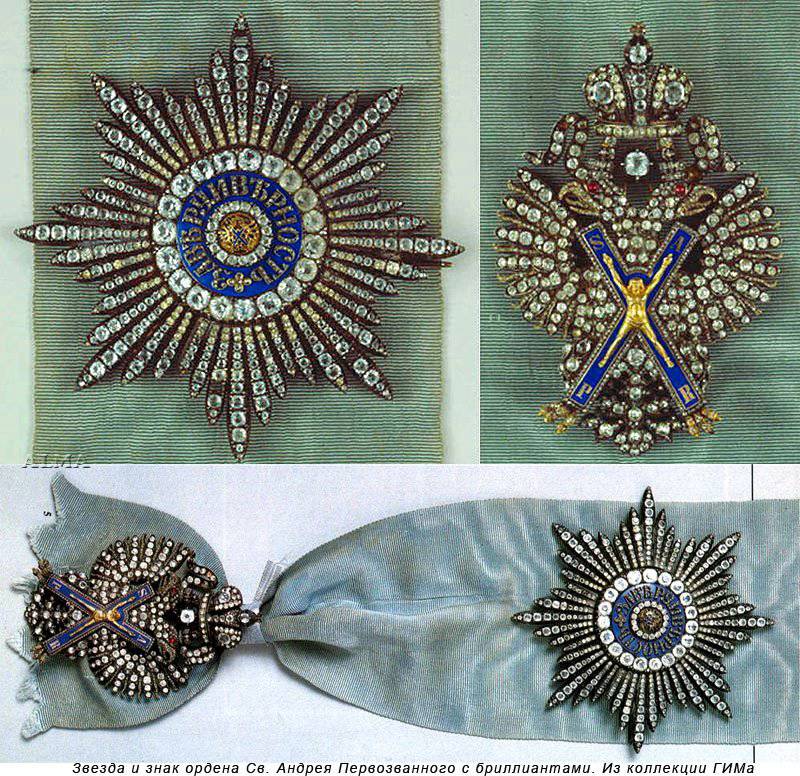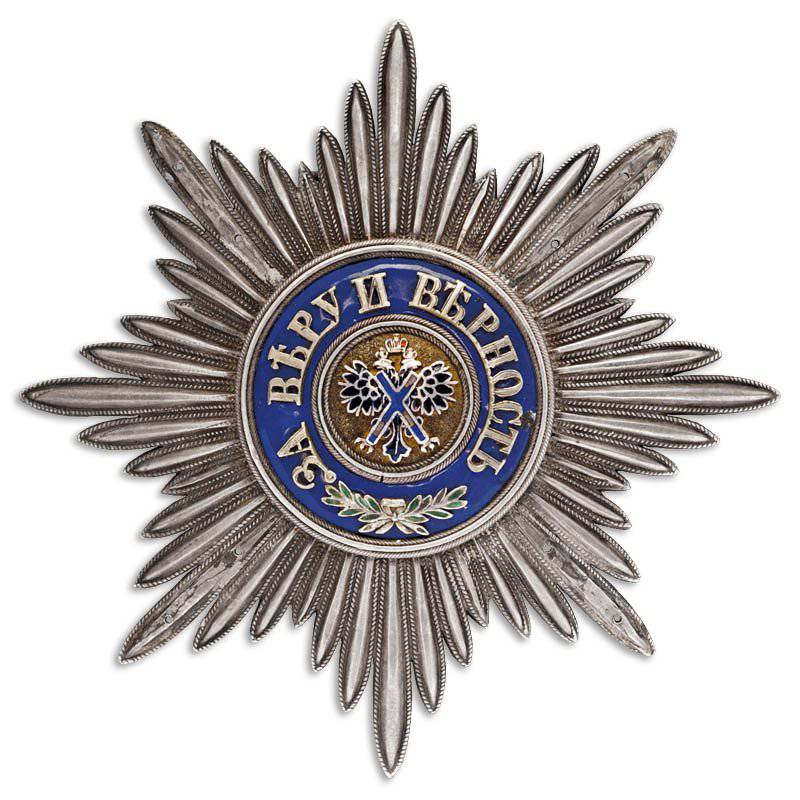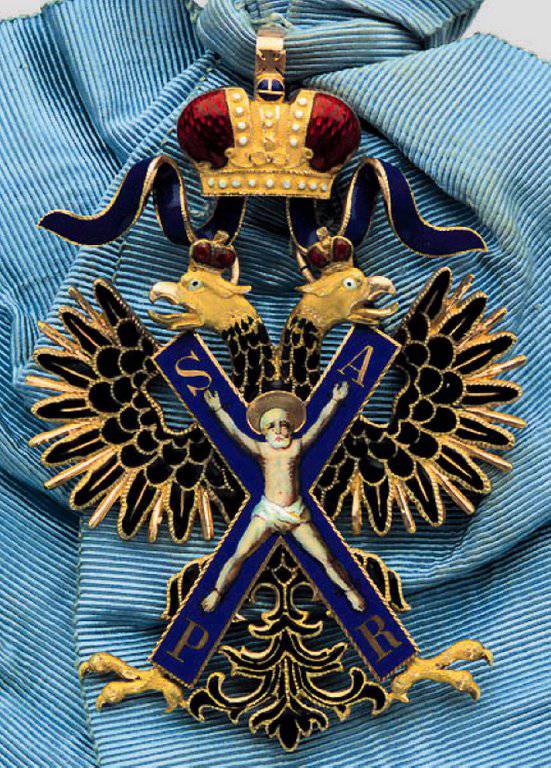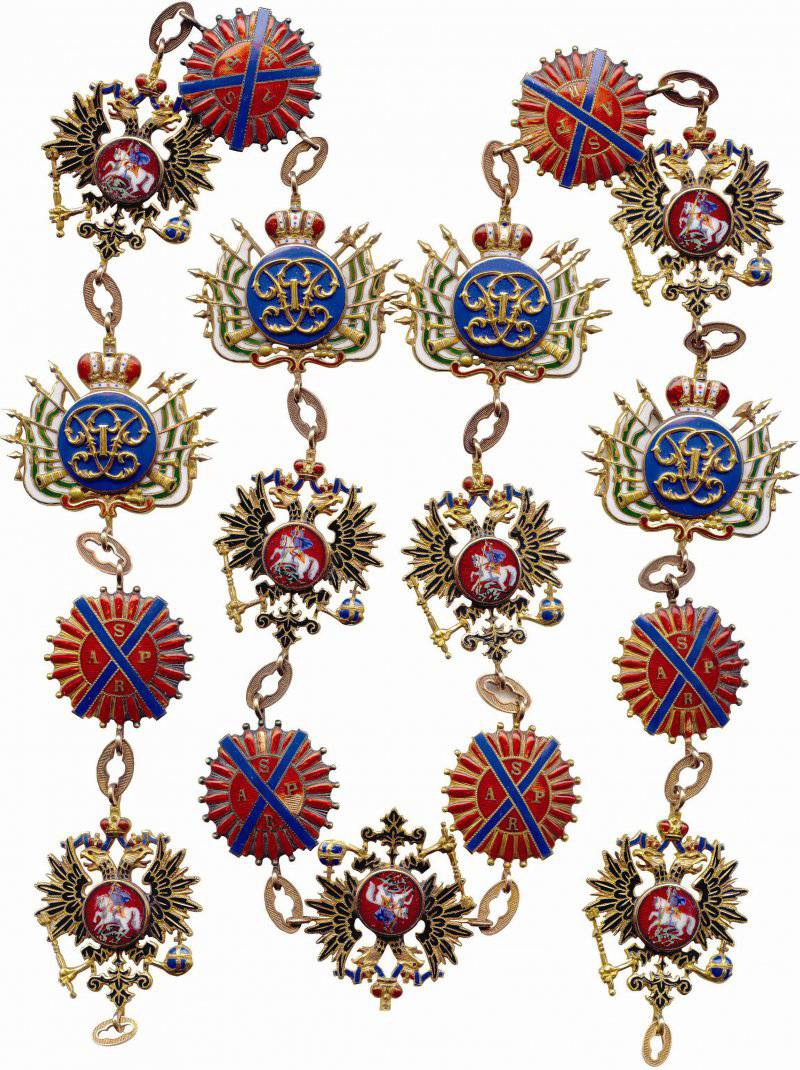Orders and medals of the Russian Empire. Order of the Holy Apostle Andrew the First Called
The eight-pointed star, the blue ribbon, which was worn over his shoulder, and the sign of St. Andrew’s Cross, an oblique crucifix, on which, according to legends, the Apostle Andrew the First-Called, once considered to be one of the most revered heavenly patrons of Russia, was handed to the award. The choice of heavenly patron for the order was not accidental. It is explained by church legends, according to which the first sermons of Christianity on the Russian lands were held by the Apostle Andrew.
The Apostle Andrew is revered in Russia since the time of the rule of Kiev princes. At one time, the legend about him as the closest disciple of Christ, who preached the Black Sea and Balkan peoples, was picked up by Constantinople (the first center of the Orthodox world) in a dispute over primacy with Catholic Rome, which was very proud of the ancient, "apostolic" rank of its Christian communities. Russia, which became the main successor of Byzantium, the “Third Rome”, also tried to do everything in order to confirm the truth of its state religion by reference to times of the distant past. So, the Scythians, who at one time preached Andrew the First-Called, were associated with the Slavs. There was a legend that it was the Apostle Andrew who first made his way “from the Greeks to the Varangians”, that is, he passed all the lands of Russia from south to north. During his journey, he visited and blessed the places on which the cities of Kiev and Novgorod were founded in the future. It is believed that the apostle Andrew ended his life crucified on a cross, the bars of which were fastened obliquely, and he himself received the designation St. Andrew's Cross.

Since most of his life the apostle Andrew spent in constant wanderings around the world, he is also considered the patron saint of navigators. Perhaps this circumstance also played a role at the moment when Peter I was engaged in symbolism for the first Russian order in history. In addition, in establishing the Russian naval flag in 1699, Peter I chose for him the St. Andrew’s blue cross.
The first cavalier of the new award was General-Admiral F. A. Golovin, who was awarded in 1699 and headed the Chapter of the Order of the Holy Apostle Andrew the First-Called as his first cavalier. Soon after this, Golovin also became the Russian field marshal general. Curiously, the second award was received by the Ukrainian hetman I. S. Mazepa in 1700, however, already in 1708, he was deprived of this highest state award for treason. The third gentleman of the order was the Brandenburg envoy B. P. Printzen (awarded in 1701 year), the fourth - Field Marshal BP P. Sheremetev (awarded in 1701 year), the fifth - Saxon Chancellor Count Beyhling (awarded in 1703 year). The Russian emperor himself received only the sixth award, it happened in 1703 year. The award to Peter I was presented by the first holder of the Order F. A. Golovin. The king was awarded the order for the capture of two Swedish ships at the mouth of the Neva. Peter I directed the seizure of ships personally in the rank of scorer-captain. For the same feat, A. D. Menshikov and the future Supreme Chancellor, Count GI Golovkin were represented.
According to the statute of the Order of St. Andrew the First-Called, they could be awarded to individuals for the accomplishment of military exploits, for public service: “... so that looking at these clear signs of mercy and advantages, encourage others to brave and faithful services and other feats in military and peacetime ... "The draft statute of the Order of 1720, the year assumed the head of the Order of the Russian tsar. Initially it was assumed that the Order gentlemen would be no more than 24 - equally Russian and foreign, but during the life of Peter I, who from the year 1721 became known as the All-Russian emperor, the number of the Order gentlemen reached 38, and was never limited in the future.

Star of the order
Later, the statute of the order and its appearance also changed. For example, 5 on April 1797 of the year, on the day of the coronation of Emperor Paul I, a statutory provision was established that actually existed since the times of Emperor John Antonovich. According to this provision, all male babies — the grand dukes — were awarded the Order of St. Andrew the First-Called at baptism. During the reign of Emperor Paul I, an order of the first time was awarded to a representative of the clergy - Metropolitan of Novgorod and St. Petersburg Gabriel.
From 1797, the order was officially decorated with diamonds. These decorations were the highest degree of the Order of St. Andrew the First Called. From 5 in August 1855, following the Highest Order to the Order, which was awarded for military exploits, began to add crossed swords, which were located at the top of the cross under the crown and through the middle of the star. The man who was awarded the Order of St. Andrew the First-Called automatically became a knight of four lower orders of the Russian Empire - St. Alexander Nevsky, White Eagle, St. Anna 1 degree, St. Stanislav 1 degree, the signs of which were awarded to the awarded person together with the Order of St. Andrew the First Called.
The badge of the order was a blue St. Andrew's cross, which was superimposed on a double-headed eagle, crowned with three crowns. The image of the crucified Holy Apostle was placed on the cross, the 4 Latin letters were placed at the ends of the cross: S. R. R. R. - Sanctus Andreas Patronus Russiae (St. Andrew, patron of Russia). On the back side was a ribbon with the motto of the award: “For faith and loyalty.” The badge of the order was worn on a special blue moire ribbon, slung over the right shoulder, the width of the tape was 10 cm.

Badge of the Order
Also included in the award were a star and an order chain. The star had eight rays and was made of silver. She was worn on the left side of the chest. In the center of the star on the gold medallion there was a two-headed black eagle with a blue St. Andrew’s cross on its chest. On a circle around the medallion on a blue background was the motto of the award. Up to 1800, in the center of the medallion there was only a large St. Andrew's cross, there was no eagle.
The order chain was complex and initially included 30 alternating elements. In total there were three elements in the chain: the state emblem, a trophy and a round enamel rosette with a blue St. Andrew’s cross. Trophy - emblem, decoration from weapons and military banners. When Empress Anna Ioannovna (1730-1740) received her monogram. And already Elizabeth Petrovna (1741-1761) replaced the monogram of Anna with the monogram of Emperor Peter I. At the same time, the order chain was worn only in the most solemn cases.
As already stated above, initially in the chain there were 30 links. But in 1797, their number was reduced to 23, and starting from 1856, the chain began to consist of 17 links. From 1856 in the chain there were 7 imperial eagles with the Moscow coat of arms, 6 rosettes with St. Andrew's cross and another 4 shield with Peter's monogram 1 and trophy. Before 1842, the order chain was issued very rarely, with rare exceptions, only to Russian cavaliers.
Subsequently, the external differences of the orders related mainly to the shape of the wings of the double-headed eagle, which changed in accordance with the heraldic tastes of our emperors. There were also some differences in the image on the order of the figure of the holy Apostle Andrew the First-Called: it could be painted on enamel, or carried out in relief - a stamp made of gold. From 17 June 1856, a blue enamel ribbon was placed between the upper crown and the double-headed eagle to the appearance of the order. In this form, the award existed until 1917 year, which was the last year of the Russian Empire. In total, this order was awarded from 900 to 1100 people. In 1998, it was again restored, but already in the award system of the Russian Federation.
Based on open source materials

Information